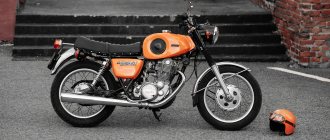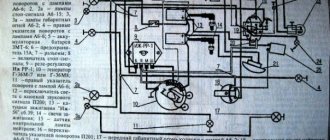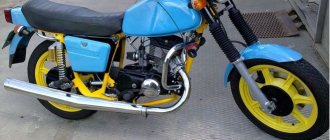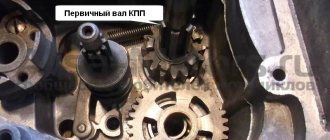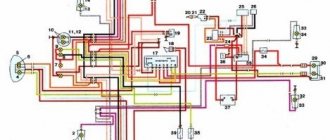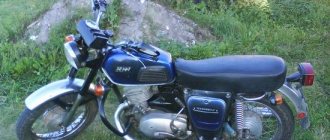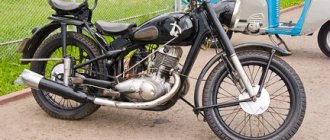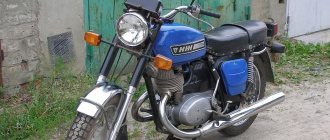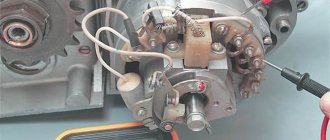The Izh motorcycle is the most popular in Russia and the then USSR. One of the most popular was considered the IZH-Planet 5. This motorcycle began to be produced in 1987 and was produced for a little over 21 years. During this time, improvements and various changes were made. In 2008, the Izhevsk plant stopped producing Planet -5.
Izh "Planet-5" is a series of road or classic motorcycles of the middle class in weight, designed for movement on various types of road surfaces, as well as on light off-road conditions.
Bearing in mind almost all the main technical characteristics, Izh “Planet-5” is not much inferior to modern analogues. This vehicle was produced by Izhevsk Motorcycles OJSC (Izhevsk). The company is currently frozen indefinitely.
Historical information
The equipment is the result of the modernization of the Planet-4 motorcycle, which itself is an improved version of the IZH-56 model. When creating the new version, the designers reduced the number of electrical wiring connectors, which increased the reliability of the lighting equipment and ignition system.
The engine received a single muffler with reduced resistance to exhaust gas flow, which had increased power and slightly increased torque. The gearshift foot has changed, fuel consumption has decreased while dynamics have increased.
Detailed review of the IZH Planeta-5 motorcycle
The classic type motorcycle is designed to carry 2 people in a single version and an additional passenger if a side trailer is installed.
The nameplate indicating the year of manufacture, identification number and additional information is located on the front frame tube.
The equipment is designed for use on roads with different surfaces (there was a “Tourist” version with a tire that had a rough tread pattern to improve maneuverability on soft soils).
Main advantages
Main advantages of the technology:
- simplicity of design;
- retro design;
- possibility of operation on low quality fuel;
- good cross-country ability due to high torque at low speeds;
- possibility of repairing the chassis and transmission in the field.
Motorcycle engine characteristics
- Number of engine cylinders - 1.
- The diameter and height of the cylinder are 72*85 mm.
- The piston stroke is 85 mm.
- Engine capacity - 346 cm3.
- Compression ratio - 7.51.
- Engine power - 18 liters. With.
- Cooling type: air.
- Carburetor type - K-36I, K-62I.
But people fell in love with the motorcycle not only for the ease of repair and maintenance. Perhaps the main advantage of this unit was not its speed characteristics (the maximum speed that a motorcycle could reach was 110 km/h), but its cross-country ability. Of course, the characteristics of the IZH Planet-3 were inferior to many motorcycles, this also applied to acceleration dynamics, but this was compensated by increased endurance. It was she who made the model a “people's brand” among residents of villages, villages, towns, in a word, places where there were bad roads. This motorcycle was the golden mean: it was taken both for a fun ride, and for going fishing, hunting, and also to bring some kind of cargo. With a curb weight of 168 kg, the recommended load weight was 170 kg, and this, they say, was not the limit.
The simplicity of the engine design, its unpretentiousness, durability, and well-designed cooling were most suitable for low-speed travel in difficult terrain. The motorcycle engine developed the highest torque in first gear, and this happened already at a speed of about 25 km/h. This made it possible to pass in places where other motorcycles skidded or stalled.
Design and appearance
In appearance, the motorcycle corresponds to the classical Soviet school. The fuel tank with rubber linings and a large manufacturer's emblem harmoniously flows into a flat seat, behind which there is a small casing with a combination lamp.
A plastic instrument panel with a speedometer, ignition switch and warning lamps is installed. Spoke wheels with aluminum brake drums emphasize the retro style, which even alloy wheels, installed since the mid-90s, cannot spoil.
Exterior view of the IZH Planeta-5 motorcycle.
Engine with one cylinder having a diameter of 72 mm.
Transmission
The motorcycle was equipped with a multi-plate clutch (6 or 7 friction pairs) located in an oil bath. To open the disks, a worm or cam type drive was used from a lever on the steering wheel.
The gearbox with 4 forward gears was located in a single crankcase with the engine.
Torque was transmitted to the rear wheel by a closed chain, which required periodic washing and lubrication. To select speeds, a double-arm lever with a foot drive was used, located on the side of the crankcase of the power unit.
Gearbox with 4 gears
Chassis and brakes
The motorcycle was equipped with a space frame welded from steel pipes. The front wheel has a telescopic fork and a pair of hydraulic shock absorbers with additional springs.
On some cars with a disc front brake, a pneumatic stiffness regulator was used. The rear wheel was equipped with a lever suspension with 2 shock absorbers with a spring and a hydraulic cavity filled with oil.
At the front, a drum shoe brake with a manual cable drive was used. The disc mechanism was equipped with a floating bracket with hydraulic control using a lever on the steering wheel.
The rear wheel and side trailer were equipped with foot-operated drum brakes. The ABS system was installed on experimental units that were not sold at retail.
Wheels
Initially, the motorcycle used spoked wheels with discs with a diameter of 18″, regardless of the installation location. With the introduction of the disc brake, the original wheel with spokes began to be installed in front, and then a cast aluminum alloy.
Tires measuring 3.5x18" were standard; on the tourist version, a 3.75x18" tire with a developed tread pattern was installed at the rear. When using a front alloy wheel, a standard 3.25x18″ tire was used.
Spoked wheels with 18″ diameter discs are installed.
Electronics
The motorcycle was equipped with a battery contact or electronic contactless ignition system. The voltage in the on-board network was 12 V, the negative terminals were connected to the frame.
A generator with a power of 70 to 140 W and a lead-acid battery with a capacity of 9 Ah were used as power sources. The lighting system included a headlight and a combined rear lamp.
There were direction indicators and a sound signal. A separate connector was provided for connecting the electrical circuits of the onboard trailer.
Dashboard of IZH Planet-5.
Weight and dimensions
Basic parameters of a single motorcycle:
- length – 2200 mm;
- width – 810 mm;
- height (without windshield) – 1200 mm;
- base – 1450 mm;
- ground clearance - 135 mm;
- dry weight – 162 kg;
- permissible load – 170 kg.
Controllability
The motorcycle has good maneuverability, corresponding to its dynamic capabilities. The technology reacts sensitively to steering wheel deviation, but requires precise adjustment of tire pressure and proper functioning of shock absorbers. When installing a side trailer, maneuverability is impaired.
Fuel consumption
The fuel supply was stored in a tank with a capacity of 18 liters; a mixture of gasoline and oil was used as fuel. Some motorcycles were equipped with a motor with a separate lubrication system, which supplied oil with a pump depending on the riding mode.
When driving on a flat highway at an average speed of about 90 km/h, the consumption was about 5 liters of fuel; in urban mode with sudden starts, the parameter reached 6.5–7 liters per 100 km.
The publication
Back in 1971, the first motorcycle “IZH Planet-3” rolled off the Izhevsk assembly line. Initially, it was designed as a budget version for the middle class and was, in fact, a stripped-down version of IZH Jupiter-3. The new product has gained great popularity among the population. This is confirmed by the fact that between 1971 and 1977 more than 450 thousand copies of the basic version of the motorcycle were produced. And this is not surprising, because despite its relative cheapness, it was unpretentious and “omnivorous,” as well as sufficient endurance and many compatible parts, which greatly simplified repairs. It was also the first motorcycle to have standard turn signals.
Service Features
The motorcycle was created in the 80s. last century, taking into account the specifics of the operation of equipment in the USSR. The piston group is not designed for long mileage and requires replacement after 10–15 thousand km.
The factory instructions list routine measures, the implementation of which ensures safe movement and ease of starting the engine.
Repair
Servicing or restoring a motorcycle does not require the use of special equipment. But high-quality engine or frame repairs with restoration of geometry and rigidity can only be performed in a specialized service.
The owner will be able to correct minor defects in the electrical system, install new tires or spark plugs. When operating a motorcycle, you should take into account the factory regulations and promptly adjust or service the main components.
Experienced technicians can repair the engine themselves.
Spare parts
On the market you often find components made in China or made by small Russian companies that have low quality workmanship.
Owners are forced to look for parts from the Soviet period, which are still often found on trading floors. The cost of components starts from several hundred rubles; there are also expensive parts. For example, a new cylinder with a piston group will cost about 12 thousand rubles.
Tuning
A weak frame and archaic rear wheel suspension impose limitations on the possibilities of modifying the motorcycle. Some owners make aerodynamic shields from fiberglass; they allow you to change the appearance of the equipment.
There are modifications to the exhaust system or head lighting, and it is possible to modify the fuel tank or seats for the driver and passenger.
But gradually the realization comes that Planet-5 is part of the history of the Soviet motorcycle industry, and many owners strive to restore the equipment to its original factory form.
The second wind of the IZH motorcycle.
Characteristics of the base model
As for the technical characteristics of IZH Planet-3, they were very close to those of its “elder brother”. The clutch and gearbox were structurally similar to each other. But, despite all the similarities, the parts were not interchangeable. The IZH Planet-3 engine was single-cylinder, and its volume was 346 cm3, which is only 1 cm3 less than the previous model. But at the same time its power was 25 hp. s., versus 18 hp. With. prototype. Both engines were two-stroke. The power unit had a return-loop purge system. But due to the imbalance of the parts, the engine created very strong vibration. There was another innovation that began to be used on this model. In order to simplify the repair and maintenance of equipment, the designers provided for the installation of a collapsible crankshaft. This made it possible to repair the motorcycle gearbox without dismantling the unit itself.
Motorcycle modifications
The plant produced several modifications of the motorcycle:
- basic version IZH 7.107;
- the “Lux” version under the symbol IZH 7.107L, which was distinguished by the installation of shields to protect the driver’s knees, a transparent glass fairing and a luggage basket;
- version IZH 7.108 with a VMZ-9.203 side trailer and a drive gear with an increased number of teeth;
- version IZH 7.107T for tourists, which featured a rear wheel with a developed tread and an increased width of the treadmill.
In 1989, the motorcycle was modernized, which led to a change in designation to Planet-5-01. In addition to contactless ignition, engines with a separate lubrication system and a front disc brake appeared.
The plant offered customers several modifications, which were equipped with guards or alloy wheels. The “Lux” and “Tourist” models disappeared from the production range.
Owner reviews
Oleg, 54 years old, St. Petersburg
In my youth I was the owner of Planet-5, so I decided to purchase and restore a similar motorcycle. We managed to find a 1988 copy that had not been modified or damaged in an accident. We had to restore the paintwork that had been damaged by storing the equipment in a damp garage. There were problems finding spare parts; there are a lot of Chinese components on the market with poor workmanship. I use the motorcycle for periodic trips to various events dedicated to old motorcycles.
Kirill, 38 years old, Tula
In the village there is a Planet-5 motorcycle with a side trailer, which was bought by relatives in 1991. The equipment is used for transporting small loads, going out into nature or picking mushrooms. I fill it with a mixture of A-92 gasoline and special oil for 2-stroke engines. I have no problems starting, but there are pockets of corrosion on the fenders and body of the trailer. At the beginning of the summer season and in the fall, I carry out maintenance in accordance with the factory instructions. I want to restore the motorcycle to its original form, but I don’t have free time.
